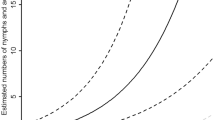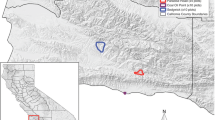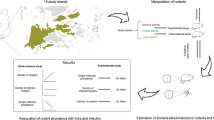Abstract
The pathogens causing Lyme disease are all vectored by generalist tick species found on a wide range of vertebrates, but spatial and annual variation in host use has rarely been quantified. We here compare the load of Ixodes ricinus (the vector) on small mammals and investigate the infection prevalence of Borrelia burgdorferi s.l. (the pathogen) involved in the enzootic transmission cycle of Lyme disease in two contrasting ecosystems in Norway from 2014 to 2016. The most common larval tick host in the eastern region was the bank vole, while the common shrew dominated in the western region of Norway. However, the wood mouse and the bank vole had consistently higher larval tick loads than the common shrew in both ecosystems. Hence, the evidence indicated that species are differently suitable as hosts, regardless of their abundances. The pathogen infection prevalence was similar among small mammal species, but markedly higher in the region with larger small mammal populations and higher tick loads, while the seasonal and annual variation was less marked. Our study indicated that the generalist I. ricinus shows consistent patterns of load on species of small vertebrate hosts, while B. burgdorferi s.l. (B. afzelii) was a true generalist. The similar roles of host species across regions suggest that disease dynamics can be predicted from host community composition, but predicting the role of host community composition for disease dynamics requires a detailed understanding of the different species population limitations under global change.


Similar content being viewed by others
References
Abrahamsen J, Jacobsen NK, Kalliola R, Dahl E, Wilborg L, Påhlsson L (1977) Naturgeografisk region-inndeling av Norden. Nordiske Utredn Ser B 34:1–135
Allender CJ, Easterday WJ, Van Ert MN, Wagner DM, Keim P (2004) High-throughput extraction of arthropod vector and pathogen DNA using bead milling. Biotechniques 37:730–734
Bjørnstad ON, Falck W, Stenseth NC (1995) A geographic gradient in small rodent density fluctuations: a statistical modelling approach. Proc R Soc Lond Ser B 262:127–133
Bockenstedt LK, Mao J, Hodzic E, Barthold SW, Fish D (2002) Detection of attenuated, noninfectious spirochetes in Borrelia burgdorferi—infected mice after antibiotic treatment. J Infect Dis 186:1430–1437
Bolnick DI, Svanbäck R, Fordyce JA, Yang LH, Davis JM, Hulsey CD, Forister ML (2003) The ecology of individuals: incidence and implications of individual specialization. Am Nat 161:1–28
Bown KJ, Lambin X, Telford G, Heyder-Bruckner D, Ogden NH, Birtles RJ (2011) The common shrew (Sorex araneus): a neglected host of tick-borne infections? Vector Borne Zoonot 11:947–953
Brisson D, Dykhuizen DE (2004) ospC Diversity in Borrelia burgdorferi: different hosts are different niches. Genetics 168:713
Brisson D, Dykhuizen DE, Ostfeld RS (2008) Conspicuous impacts of inconspicuous hosts on the Lyme disease epidemic. Proc R Soc Lond Ser B 275:227–235
Cayol C, Koskela E, Mappes T, Siukkola A, Kallio ER (2017) Temporal dynamics of the tick Ixodes ricinus in northern Europe: epidemiological implications. Parasite Vector 10:166
Clow KM, Ogden NH, Lindsay LR, Michel P, Pearl DL, Jardine CM (2017) The influence of abiotic and biotic factors on the invasion of Ixodes scapularis in Ontario, Canada. Ticks Tick Borne Dis 8:554–563
Coipan EC, Sprong H (2016) Ecology of Borrelia burgdorferi sensu lato. In: Van Braks MAH, Van Wieren SE, Takken W, Sprong H (eds) Ecology and prevention of Lyme disease. Wageningen Academic Publishers, Wageningen, pp 41–61
Cornetti L, Hilfiker D, Lemoine M, Tschirren B (2018) Small-scale spatial variation in infection risk shapes the evolution of a Borrelia resistance gene in wild rodents. Mol Ecol 27:3515–3524
Cornulier T, Yoccoz NG, Bretagnolle V, Brommer JE, Butet A, Ecke F, Elston DA, Framstad E, Henttonen H, Hörnfeldt B, Huitu O, Imholt C, Ims RA, Jacob J, Jedrzejewska B, Millon A, Petty SJ, Pietiäinen H, Tkadlec E, Zub K, Lambin X (2013) Europe-wide dampening of population cycles in keystone herbivores. Science 340:63–66
Courtney JW, Kostelnik LM, Zeidner NS, Massung RF (2004) Multiplex real-time PCR for detection of Anaplasma phagocytophilum and Borrelia burgdorferi. J Clin Microbiol 42:3164–3168
Davis S, Trapman P, Leirs H, Begon M, Heesterbeek JAP (2008) The abundance threshold for plague as a critical percolation phenomenon. Nature 454:634–637
Dizij A, Kurtenbach K (1995) Clethrionomys glareolus, but not Apodemus flavicollis, acquires resistance to Ixodes ricinus L., the main European vector of Borrelia burgdorferi. Parasite Immunol 17:177–183
Ecke F, Angeler DG, Magnusson M, Khalil H, Hörnfeldt B (2017) Dampening of population cycles in voles affects small mammal community structure, decreases diversity, and increases prevalence of a zoonotic disease. Ecol Evol 7:5331–5342
Estrada-Peña A, de la Fuente J, Ostfeld RS, Cabezas-Cruz A (2015) Interactions between ticks and transmitted pathogens evolved to minimise competition through nested and coherent networks. Sci Rep 5:10361
Franke J, Hildebrandt A, Dorn W (2013) Exploring gaps in our knowledge on Lyme borreliosis spirochaetes-updates on complex heterogeneity, ecology, and pathogenicity. Ticks Tick Borne Dis 4:11–25
Futuyma DJ, Moreno G (1988) The evolution of ecological specialization. Ann Rev Ecol Syst 19:207–233
Gandon S (2018) Evolution and manipulation of vector host choice. Am Nat 192:23–34
Gasmi S, Ogden NH, Leighton PA, Lindsay LR, Thivierge K (2016) Analysis of the human population bitten by Ixodes scapularis ticks in Quebec, Canada: increasing risk of Lyme disease. Ticks Tick Borne Dis 7:1075–1081
Gern L, Siegenthaler M, Hu CM, Leuba-Garcia S, Humair PF, Moret J (1994a) Borrelia burgdorferi in rodents (Apodemus flavicollis and A. sylvaticus): duration and enhancement of infectivity for Ixodes ricinus ticks. Eur J Epidemiol 10:75–80
Gern L, Siegenthaler M, Hu CM, Leuba-Garcia S, Humair PF, Moret J (1994b) Borrelia burgdorferi in rodents (Apodemus flavicollis and A. sylvaticus): duration and enhancement of infectivity for Ixodes ricinus ticks. Eur J Epidemiol 10:75–80
Gern L, Estrada-Peña A, Frandsen F, Gray JS, Jaenson TGT, Jongejan F, Kahl O, Korenberg E, Mehl R, Buttall PA (1998) European reservoir hosts of Borrelia burgdorferi sensu lato. Zentralblatt für Bakteriologie 287:196–204
Han BA, Schmidt JP, Bowden SE, Drake JM (2015) Rodent reservoirs of future zoonotic diseases. PNAS 112:7039–7044
Hanski I, Kaikusalo A (1989) Distribution and habitat selection of shrews in Finland. Ann Zool Fenn 26:339–348
Hofmeester TR, Coipan EC, Van Wieren SE, Prins HHT, Takken W, Sprong H (2016) Few vertebrate species dominate the Borrelia burgdorferi s.l. life cycle. Environ Res Lett 11:043001
Imholt C, Reil D, Plasil P, Rödiger K, Jacob J (2017) Long-term population patterns of rodents and associated damage in German forestry. Pest Manag Sci 73:332–340
Ims RA, Andreassen HP (2000) Spatial synchronization of vole population dynamics by predatory birds. Nature 408:194–196
Johnson PTJ, de Roode JC, Fenton A (2015) Why infectious disease research needs community ecology. Science 349:1259504
Jore S, Viljugrein H, Hofshagen M, Brun-Hansen H, Kristoffersen A, Nygard K, Ottesen P, Saevik B, Ytrehus B, Brun E (2011) Multi-source analysis reveals latitudinal and altitudinal shifts in range of Ixodes ricinus at its northern distribution limit. Parasite Vector 4:84
Kilpatrick AM, Dobson ADM, Levi T, Salkeld DJ, Swei A, Ginsberg HS, Kjemtrup A, Padgett KA, Jensen PM, Fish D, Ogden NH, Diuk-Wasser MA (2017) Lyme disease ecology in a changing world: consensus, uncertainty and critical gaps for improving control. Philos Trans R Soc Lond Ser B 372:20160117
Korpimäki E, Norrdahl K, Huitu O, Klemola T (2005) Predator-induced synchrony in population oscillations of coexisting small mammal species. Proc R Soc Lond Ser B 272:193–202
Kraiczy P (2016) Travelling between two worlds: complement as a gatekeeper for an expanded host range of Lyme disease spirochetes. Vet Sci 3:12
Krasnov BR, Poulin R, Shenbrot GI, Mouillot D, Khokhlova IS (2004) Ectoparasitic “jacks-of-all-trades”: relationship between abundance and host specificity in fleas (Siphonaptera) parasitic on small mammals. Am Nat 164:506–516
Krasnov BR, Stanko M, Morand S (2007) Host community structure and infestation by ixodid ticks: repeatability, dilution effect and ecological specialization. Oecologia 154:185–194
Kurtenbach K, Sewell H-S, Ogden NH, Randolph SE, Nuttall PA (1998) Serum complement sensitivity as a key factor in Lyme disease ecology. Infect Immun 66:1248–1251
Kurtenbach K, De Michelis S, Etti S, Schaefer SM, Sewell HS, Brade V, Kraiczy P (2002) Host association of Borrelia burgdorferi sensu lato—the key role of host complement. Trends Microbiol 10:74–79
Luque-Larena JJ, Mougeot F, Arroyo B, Vidal M, Rodríguez-Pastor R, Escudero R, Anda P, Lambin X (2017) Irruptive mammal host populations shape tularemia epidemiology. PLoS Pathog 13:e1006622
McCoy KD, Leger E, Dietrich M (2013) Host specialization in ticks and transmission of tick-borne diseases: a review. Front Cell Infect Microbiol 3:57
Medlock JM, Hansford KM, Bormane A, Derdakova M, Estrada-Peña A, George J-C, Golovljova I, Jaenson TGT, Jensen J-K, Jensen PM, Kazimirova M, Oteo JA, Papa A, Pfister K, Plantard O, Randolph SE, Rizzoli A, Santos-Silva MM, Sprong H, Vial L, Hendrickx G, Zeller H, van Bortel W (2013) Driving forces for changes in geographical distribution of Ixodes ricinus ticks in Europe. Parasite Vector 6:1
Myllymäki A, Paasikallio A, Pankakoski E, Kanervo V (1971) Removal experiments on small quadrats as a means of rapid assessment of the abundance of small mammals. Ann Zool Fenn 8:177–185
Mysterud A, Easterday WR, Qviller L, Viljugrein H, Ytrehus B (2013) Spatial and seasonal variation in prevalence of Anaplasma phagocytophilum and Borrelia burgdorferi in Ixodes ricinus ticks in Norway. Parasite Vector 6:187
Mysterud A, Byrkjeland R, Qviller L, Viljugrein H (2015) The generalist tick Ixodes ricinus and the specialist tick Ixodes trianguliceps on shrews and rodents in a northern forest ecosystem—a role of body size even among small hosts. Parasite Vector 8:639
Mysterud A, Easterday WR, Stigum VM, Aas AB, Meisingset EL, Viljugrein H (2016) Contrasting emergence of Lyme disease across ecosystems. Nat Commun 7:11882
Mysterud A, Jore S, Østerås O, Viljugrein H (2017) Emergence of tick-borne diseases at northern latitudes in Europe: a comparative approach. Sci Rep 7:16316
Mysterud A, Stigum VM, Seland IV, Herland A, Easterday WJ, Jore S, Østerås O, Viljugrein H (2018) Tick abundance, pathogen prevalence, and disease incidence in two contrasting regions at the northern distribution range of Europe. Parasite Vector 11:309
Mysterud A, Stigum VM, Jaarsma R, Sprong H (2019) Genospecies of Borrelia burgdorferi detected in 16 mammal species and questing ticks from Norway. Sci Rep 9:5088
Ostfeld RS, Canham CD, Oggenfuss K, Winchcombe RJ, Keesing F (2006) Climate, deer, rodents, and acorns as determinants of variation in Lyme-disease risk. PLoS Biol 4:1058–1068
Paulauskas A, Ambrasiene D, Radzijevskaja J, Rosef O, Turcinaviciene J (2008) Diversity in prevalence and genospecies of Borrelia burgdorferi senso lato in Ixodes ricinus ticks and rodents in Lithuania and Norway. Int J Med Microbiol 298(S1):180–187
R Development Core Team (2016) R: a language and environment for statistical computing. R Foundation for Statistical Computing, Vienna
Råberg L, Hagström Å, Andersson M, Bartkova S, Scherman K, Strandh M, Tschirren B (2017) Evolution of antigenic diversity in the tick-transmitted bacterium Borrelia afzelii: a role for host specialization? J Evol Biol 30:1034–1041
Radolf JD, Caimano MJ, Stevenson B, Hu LT (2012) Of ticks, mice and men: understanding the dual-host lifestyle of Lyme disease spirochaetes. Nat Rev Microbiol 10:87–99
Rigaud T, Perrot-Minnot M-J, Brown MJF (2010) Parasite and host assemblages: embracing the reality will improve our knowledge of parasite transmission and virulence. Proc R Soc Lond Ser B 277:3693–3702
Rødven R, Männikkö I, Ims RA, Yoccoz NG, Folstad I (2009) Parasite intensity and fur coloration in reindeer calves—contrasting artificial and natural selection. J Anim Ecol 78:600–607
Røed KH, Kvie K, Hasle G, Gilbert L, Leinaas HP (2016) Phylogenetic lineages and postglacial dispersal dynamics characterize the genetic structure of tick, Ixodes ricinus, in Northwest Europe. PLoS One 11:e0167450
Sajanti E, Virtanen M, Helve O, Kuusi M, Lyytikäinen O, Hytönen J, Sane J (2017) Lyme Borreliosis in Finland, 1995–2014. Emerg Infect Dis 23:1282
Sexton JP, Montiel J, Shay JE, Stephens MR, Slatyer RA (2017) Evolution of ecological niche breadth. Annu Rev Ecol Evol Syst 48:183–206
Shaw DJ, Dobson AP (1995) Patterns of macroparasite abundance and aggregation in wildlife populations: a quantitative review. Parasitology 111:S111–S133
Skaug H, Fournier D, Nielsen A (2006) glmmADMB: generalized linear mixed models using AD model builder. http://glmmadmb.r-forge.r-project.org/. Accessed 6 May 2019
Strann K-B, Yoccoz NG, Ims RA (2002) Is the heart of Fennoscandian rodent cycle still beating? A 14-year study of small mammals and Tengmalm’s owl in northern Norway. Ecography 25:81–87
Swei A, Ostfeld RS, Lane RS, ClJ Briggs (2011) Impact of the experimental removal of lizards on Lyme disease risk. Proc R Soc Lond Ser B 278:2970
Tälleklint L, Jaenson TGT (1993) Maintenance by hares of European Borrelia burgdorferi in ecosystems without rodents. J Med Entomol 30:273–276
Tälleklint L, Jaenson TGT (1994) Transmission of Borrelia burgdorferi s.l. from mammal reservoirs to the primary vector of Lyme borreliosis, Ixodes ricinus (Acari, Ixodidae), in Sweden. J Med Entomol 31:880–886
Tälleklint L, Jaenson TGT (1995) Is the small mammal (Clethrionomys glareolus) or the tick vector (Ixodes ricinus) the primary overwintering reservoir for the Lyme borreliosis spirochete in Sweden? J Wildl Dis 31:537–540
Tälleklint L, Jaenson TGT (1997) Infestation of mammals by Ixodes ricinus ticks (Acari: Ixodidae) in south-central Sweden. Exp Appl Acarol 21:755–771
van der Kooij J, Solheim R (2002) Catch of taiga shrew Sorex isodon in Norway—new information about the species habitat use and catchability (In Norwegian). Fauna 55:175–183
van Duijvendijk G, Gort G, Takken W (2016) Rodents as hosts for Ixodes ricinus and Borrelia afzelii. In: Van Marieta AHB, Van Wieren SE, Takken W, Sprong H (eds) Ecology and prevention of Lyme borreliosis. Wageningen Academic Publishers, Wageningen, pp 63–73
Woolhouse ME, Taylor LH, Haydon DT (2001) Population biology of multihost pathogens. Science 292:1109–1112
Zarybnicka M, Riegert J, Bejcek V, Sedlacek F, Stastny K, Sindelar J, Heroldova M, Vilimova J, Zima J (2017) Long-term changes of small mammal communities in heterogenous landscapes of Central Europe. Eur J Wildl Res 63:89
Acknowledgements
We are grateful to Jeroen van der Kooij for aiding in identification of small mammal species. We are grateful to the Research Council of Norway for funding the #EcoTick Project (254469) and to the Faculty of Mathematics and Natural Sciences, UiO, for providing a scholarship to fund a sabbatical for AM of the University of Antwerp. We are grateful to an anonymous referee and the editor for comments improving our manuscript.
Author information
Authors and Affiliations
Contributions
AM conceived and designed the study. VMS, AH and HL did the field work. VMS did the DNA labwork. HL and AH did the tick counting. HV and AM did the statistical analyses and made the figures. AM drafted the paper. All authors gave their comments to the ms and final approval before submission.
Corresponding author
Ethics declarations
Ethical approval
Permissions to capture rodents and shrews were given by the Norwegian Environment Agency (reference 2013/11201) and hence conform to the Norwegian laws and regulations.
Data accessibility
Data will be deposited in Dryad upon acceptance.
Additional information
Communicated by Roland A. Brandl.
Electronic supplementary material
Below is the link to the electronic supplementary material.
Rights and permissions
About this article
Cite this article
Mysterud, A., Stigum, V.M., Linløkken, H. et al. How general are generalist parasites? The small mammal part of the Lyme disease transmission cycle in two ecosystems in northern Europe. Oecologia 190, 115–126 (2019). https://doi.org/10.1007/s00442-019-04411-2
Received:
Accepted:
Published:
Issue Date:
DOI: https://doi.org/10.1007/s00442-019-04411-2




